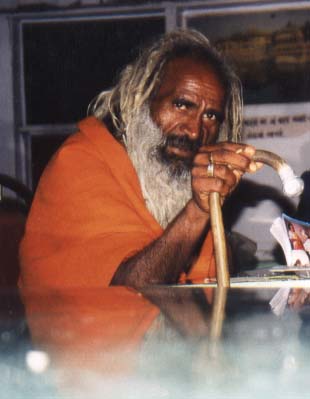|
"Sadhu Life" Sri
Premdas Babaji didn't want his photo taken. As we sip chai, Sri Premdas Babaji describes his daily routine. Each day at five in the morning, he gets up and walks down to the Betwa Nagdi (nagdi is Hindi for "river") for a ritual bath. At six, he crosses the dirt road to his bright orange Hanuman Mandir (mandir is Hindi for "temple"). There he performs his morning puja, which literally means respect; it refers to prayers or an offering. At seven, he walks up to the lean-to where we sit, lights a fire and cooks up some chai, which he sips as he gazes out over the Hanuman Mandir and the Betwa Nagdi. Along with chai he will often have a few tokes on his chillum, a straight pipe he packs with a mixture of hash and tobacco. Here he tilts his head back, utters a gregarious, infinitely likeable laugh and says, "sadhu life". You can hear his smile in those words. At ten in the morning, Sri Premdas Babaji makes his way to the Ramraja Mandir, the main temple in Orchha. The Ramraja Mandir is very much a living temple, a focal point of life in Orchha. A market splays out in the plaza in front of its gray facade, but its interior is painted with bright colors. It is actually a collection of temples, shrines to different gods and goddesses, that are situated around a courtyard. Families come to pray and to chat with each other as their children run about the courtyard rambunctiously. At seven in the evening, Sri Premdas Babaji returns to the Betwa Nagdi and then his Hanuman Mandir for evening puja, and revisits the Ramraja Mandir at ten at night. Again he laughs his infectious laugh, smiles from ear to ear and says, "sadhu life". Now he packs his chillum, a ritual in its own right. Sadhus are unmaterialistic, but a chillum often figures prominently among their few possessions. Sadhus who follow Shiva are the most likely sadhus to make frequent use of the chillum. It's an integral part of Sri Premdas Babaji's daily ritual, a ritual based on his spirituality and devotion; the chillum seems to be one form of his worship. He starts with a chunk of hash, unobtainable in Orchha but sometimes given as an offering to his Hanuman temple on Tuesday, the day of offering to Hanuman. If none is available, he will pick some marijuana from a plant in his garden. He is unusual among sadhus in that he keeps a house and garden, a physical focal point for his life rather than the spiritual wanderings for which many sadhus opt. He mixes the marijuana or hash with tobacco, taken either from a beedie or from the filterless Panama cigarettes he smoke. Beedies are filterless Indian cigarettes that come in a paper package. They are short, wrapped in a leaf like a cigar, flared at one end, and smoked all over India at about a dime a pack. He then adds a few drops of water and mashes the mixture in the palm of his hand. He places the mixture in the bowl of the chillum, which contains a small stone that functions as a screen, then tears off a small square of material from an old piece of clothing, frequently one he is wearing, to use as a filter. There are many one- and two-handed techniques for using a chillum, all with the apparent goal of keeping one's lips from touching the chillum or the cloth filter. Sri Premdas Babaji use a variety of these methods, all with considerable dexterity. He puffs repeatedly like someone lighting a cigar, and smoke envelopes his face. As he exhales a cloud of smoke, he says with an ear-splitting grin and a twinkle in his eye, "sadhu life". |
